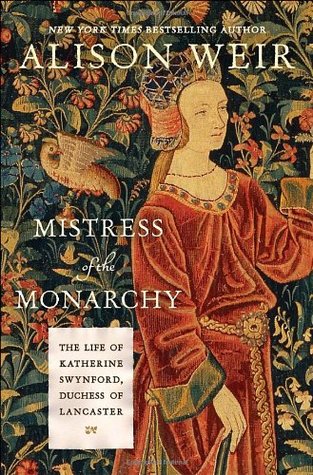I looked for a biography of Katherine Swynford after reading Anya Seton’s Katherine, a novel about her life. I had a suspicion that the story was greatly romanticized, and acclaimed biographer Alison Weir agrees with me.
The bare bones of Katherine Swynford’s story are dramatic. Of undistinguished foreign parentage, Swynford was married to a low-ranking knight in the army of John of Gaunt, the Duke of Lancaster and son of Edward III. John was the most wealthy and powerful noble of his time except for the King. Katherine was attached to the Duke’s household as sort of a governess for his children with his duchess, Blanche of Lancaster, to whom he was devoted. Katherine’s husband served overseas. (Weir has him dying of illness rather than being murdered by a servant faithful to the Duke.)
After Blanche’s death, John married Constance, titular Queen of Castile and tried for years to take back her country from usurpers. This marriage was not successful, and soon the Duke began an affair with Katherine that lasted for years. The couple parted then reunited, but Lancaster astounded everyone by marrying her after Constance’s death. Amazingly, Katherine was the ancestress of every king of England since 1399 and of six American presidents.
Although Katherine’s story is an intriguing one, there is so little historical information available about her that the biography is mostly about her husband and sons, with information derived from records of grants and budgets. This is the kind of research that is probably fascinating to the writer but not so interesting to the reader.


I loved the Anya Seton book, but haven’t read any biographies of Katherine. Sorry this one wasn’t all that interesting – that can be a problem when there’s not much information available.
That’s the problem with Middle Ages women’s bios.
I found the same with Weir’s biography of Elizabeth of York – so little info about her life that she remained as vague at the end as she had been at the beginning. And Weir did so much speculation with no evidence to back it up – the book was full of “may haves” and “might have beens”. I must admit I was deeply unimpressed.
Yes. I think she’s now into doing bios of women who she just can’t find much about, so she has to speculate.
I read Anya Seton’s book in my youth. Found it second hand and now have it on my shelves for re-reading. Sound great to combine with this book. It is great to read a non-fiction book when having read a historical fiction.
Good idea.